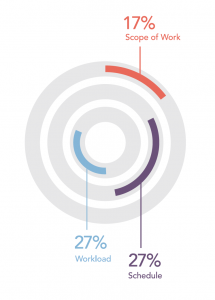
The information you provide in your job description is the first step in setting a physician’s expectations and is a critical part of making a locum tenens assignment a success.
In quality assurance surveys sent to locum tenens physicians at the end of each assignment, we ask how the responsibilities and requirements of the assignment compared to what was initially presented to them. Results of the 2014 surveys show the majority of our physicians were satisfied with the accuracy of the job description — but there is room for improvement.
In the graph to the right, we’ve compiled the top three issues listed by those who said the job description did not match the reality of the assignment. Survey comments are also valuable in assessing what providers are looking for in a job description. Concerns expressed include:
[caption id="attachment_10870" align="alignright" width="300"]

Top-three inaccuracies in job description vs. actual locum tenens assignment.[/caption]
Workload
- More patients than expected
- Fewer patients than presented
- Ratio of clinic to hospital work misrepresented
Schedule
- Long days with no time for charting
- Shorter weekly schedule than presented
- Call schedule not as indicated
Scope of work
- Condition of patients misrepresented
- Ratio of patient categories misrepresented
- Skill scope higher than expected
By making sure your job descriptions more clearly define expectations like workload, schedule, and scope of work, you will find a better match for your job and create a better experience for the physician.
How to write an effective locums job description
A good job description is critical to finding the right physician quickly. It reduces questions and allows for faster presentations of physicians. With demand outweighing supply, getting the right physician before someone else does can depend on whether comprehensive information is provided up front.
Below are job details that can help you find the right physician for the job.
Job description
- Schedule (Monday through Friday, hours, etc.)
- Call schedule (nights and weekends)
- Patients per day
- Procedures (required vs. “nice-to-have”)
- Staff information (number of additional MDs and support)
- Orientation and training schedule
- Supervisory responsibilities, if any
- Ratio of clinic to hospital work
- Specific subspecialty information (needs/requirements/pluses)
- Reason for coverage
- EMR system
- Decision-making process
Work site description
- Location
- Department summary (annual cases)
- Description of facility, community, recreation, etc.
- Upcoming events in the area
Defining your ideal candidate
If you want to find the right candidate, it’s important to know what you’re looking for. Define the following criteria before screening physicians or extending an offer.
- Acceptable corrective action history
- Acceptable criminal background
- Acceptable malpractice history (payouts, dismissals)
- Years of specialty experience
- Board status (certified, eligible within X years of completing training)
- AMG/FMG
- Availability (full-time, part-time, job share)
- EMR experience/EMR types
- Proximity to work site location
 The information you provide in your job description is the first step in setting a physician’s expectations and is a critical part of making a locum tenens assignment a success.
In quality assurance surveys sent to locum tenens physicians at the end of each assignment, we ask how the responsibilities and requirements of the assignment compared to what was initially presented to them. Results of the 2014 surveys show the majority of our physicians were satisfied with the accuracy of the job description — but there is room for improvement.
In the graph to the right, we’ve compiled the top three issues listed by those who said the job description did not match the reality of the assignment. Survey comments are also valuable in assessing what providers are looking for in a job description. Concerns expressed include:
[caption id="attachment_10870" align="alignright" width="300"]
The information you provide in your job description is the first step in setting a physician’s expectations and is a critical part of making a locum tenens assignment a success.
In quality assurance surveys sent to locum tenens physicians at the end of each assignment, we ask how the responsibilities and requirements of the assignment compared to what was initially presented to them. Results of the 2014 surveys show the majority of our physicians were satisfied with the accuracy of the job description — but there is room for improvement.
In the graph to the right, we’ve compiled the top three issues listed by those who said the job description did not match the reality of the assignment. Survey comments are also valuable in assessing what providers are looking for in a job description. Concerns expressed include:
[caption id="attachment_10870" align="alignright" width="300"] Top-three inaccuracies in job description vs. actual locum tenens assignment.[/caption]
Top-three inaccuracies in job description vs. actual locum tenens assignment.[/caption]